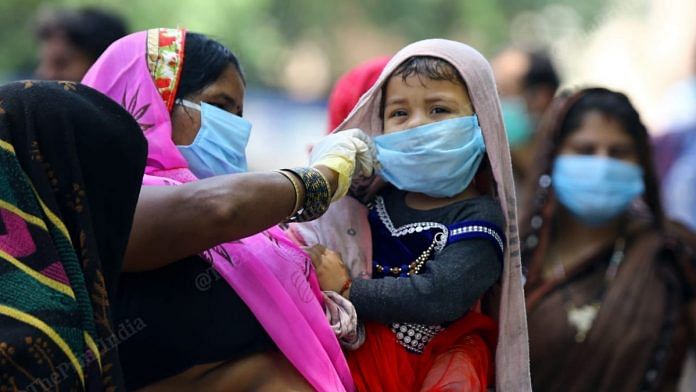New Delhi: Seasonal infection cases appear to have seen a ‘dip’ as a result of Covid-appropriate behaviour. Data shows cases of seasonal flu, a common occurrence in the months of January and February, have especially seen a decrease.
The All India Organisation of Chemist and Druggist (AIOCD-AWACS) data accessed by ThePrint has indicated that the sales of medicine for cold and flu have seen a 14 per cent drop — from Rs 3,154 crore to Rs 2,712 crore between February 2020 and February 2021.
The AIOCD is an apex lobby that consists of 8.5 lakh chemists across the country. AWACS is its research wing.
Behind the dip, experts say, is the compliance with Covid-appropriate behaviour like wearing mask and hand-washing as communicable diseases spread through droplets.
“Incidence of infections like influenza certainly seems to have dipped, anecdotally. Besides, school closure would have brought down other droplet diseases like chickenpox,” said Dr Anil Gurtoo, director professor of medicine, Lady Hardinge Medical College.
Also read: ‘Worried about Maharashtra’: Govt says state has 8 of top 10 districts with most Covid cases
Falling sales
There has been a dip in the sales of medicines for cough and cold across many brands like Dolo Cold, Torex, TusQ, Honitus, Maxtra, Ascoril, among others.
In January and February, the months when cold and flu cases generally see a rise, the sales of such medicines was hovering at Rs 200 crore. Last year, this figure was recorded at over Rs 300 crore.
According to the AIOCD-AWACS data, sales of all categories of drugs used as remedies for cold and flu have seen a fall between 10 and 28 per cent.
For instance, the sale of the category of drugs made using the combination of “chlorpheniramine and phenylephrine” such as Maxtra, T-Minic and Ascoril Flu are down by almost 17 per cent when compared to February 2020.
Then there is the category of drugs, which is made with the combination of “chlorpheniramine, paracetamol and phenylephrine” — sold as Dolo Cold, Sumo Cold and Solvin Cold — whose sales have fallen by 10 per cent.
While chlorpheniramine is an antihistamine that relieves allergy symptoms like runny nose, watery eyes and sneezing, phenylephrine is a nasal decongestant. Paracetamol is commonly used to treat pain and fever.
The category of drugs that are prescribed for respiratory infections, made through the combination of “ambroxol, guaifenesin and terbutaline” have also registered a fall of 27 per cent in their sales.
These medicines include Tusq-X Plus and Soventus that relieve coughing with mucus. The sale of another class of drugs made with “ambroxol plus levosalbutamol and guaifenesin” is down by 28 per cent. The medicines under this category include Brozedex, Asthalin, Viscodyne LS, and Mucaryl.
Also read: Bharat Biotech data on 43 Covid cases convinced govt to drop Covaxin from clinical trial mode
Experts say
ThePrint reached doctors in hospitals across the country who confirmed the decrease in seasonal infections.
Dr Anand Krishnan, a professor at the Centre for Community Medicine at All India Institute of Medical Sciences (AIIMS) in the national capital, has been involved in the setting up of the Indian Network of Population-based Platform for Influenza and other Respiratory Viruses among Elderly (INSPIRE), a surveillance project.
Krishnan commented on one of the data points that the platform threw up. “Among the elderly in rural Faridabad, ARI (acute respiratory infection) rates have halved from pre-Covid levels based on a community based surveillance. This could be a combination of actual decline and lower reporting due to stigma/fear,” he said.
Dr Indu P.S., head of department of community medicine, Government Medical College, Thrissur, shared a similar observation. “Commonly people would say that they would have two-three infections by this time, but now there have been no infections,” she said.
She made a conjecture that Covid-appropriate behaviour is likely to be the reason behind this decline.
“Basically, it’s because people are wearing masks…when wearing masks is common, respiratory infections come down. Then eateries have also closed down for some time, so the total amount of exposure might have come down when hand-washing almost became a habit,” she said.
However, Dr Pankaja Raghav, head of the department, community and family medicine, at AIIMS Jodhpur, noted the decline could also be a result of hesitancy in seeking out treatment.
Raghav, a researcher in the fields of communicable diseases, non-communicable chronic diseases and child behaviour, said, “Preventive measures adopted for the Covid-19 pandemic resulted in a profound decrease in the diagnosis of common infectious diseases among children. This has resulted either due to a decline in the prevalence of the infectious disease or due to inhibition of seeking health care facility when the condition occurred.”
She added, “There is an expected resurgence of contagious infectious diseases once the pandemic settles down and social interactions increases.”
(Edited by Amit Upadhyaya)
Also read: World will know about Covid origin ‘fairly soon’, WHO mission expert says



